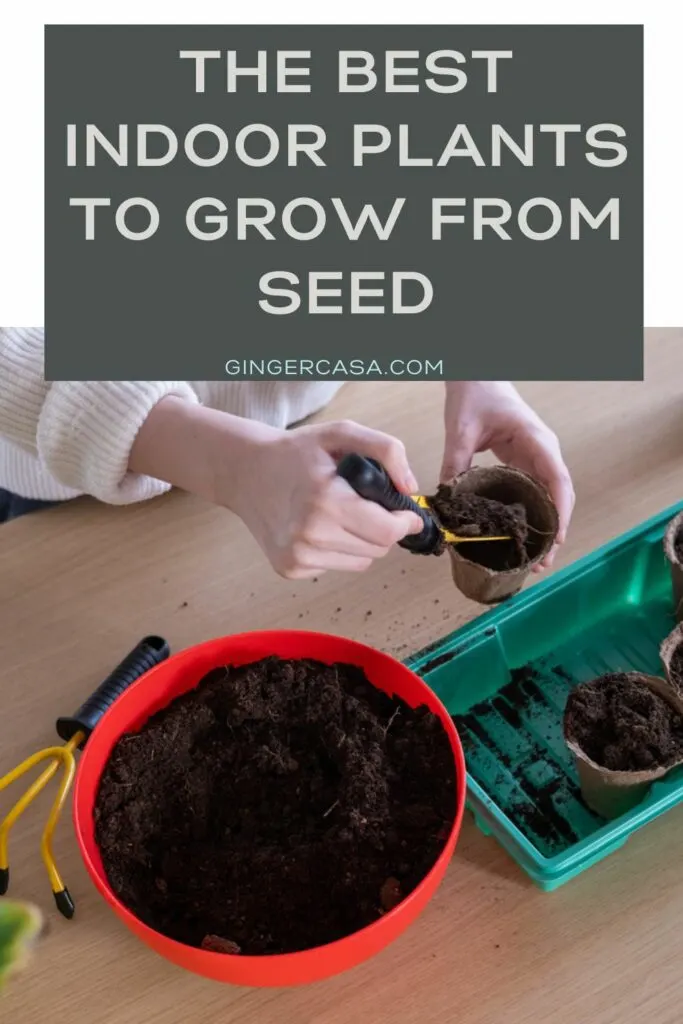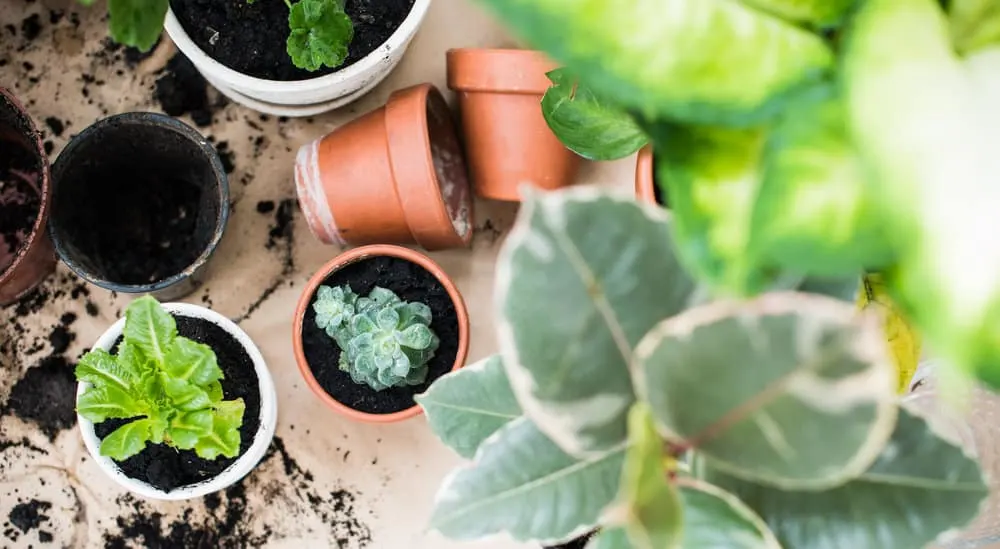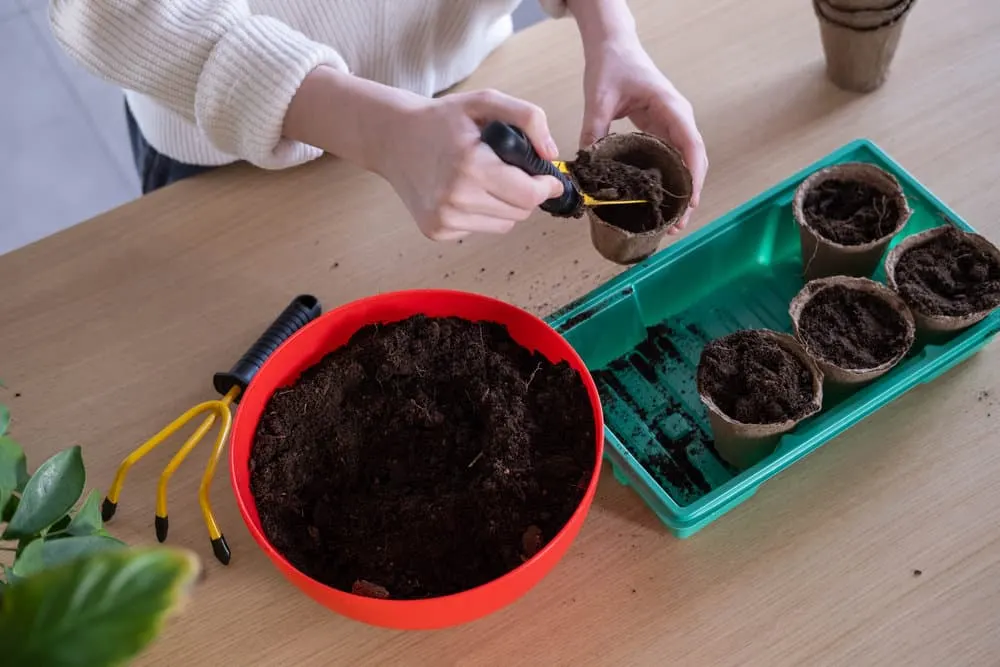What are the best indoor plants to grow from seed? Read on to find out!
Indoor plants are so much more than a casual decoration. They are a breath of fresh air, a mood booster, and a stress reducer. Plants come in a virtually unlimited variety of shapes, sizes, colors, and species, and can fit in with any home decor. Homes with southwest or western themes can be complemented with a cactus or similar plant, while bright-colored flowers work well with minimalist or modern decorating schemes. No matter what look you are going for, indoor plants can help, while offering numerous health benefits along the way.
It is hard to put a date on the first time people began to bring plants into their homes. Artifacts dating back to ancient Rome and Egypt show indoor plants in the home, often in large pots or urns. During world voyages by European conquistadors, many new exotic plants were discovered and returned to their home countries, where they were proudly displayed in the homes and palaces of the nobility. It wasn’t until the twentieth century, however, that people were able to regulate indoor temperature enough to keep indoor plants alive for long periods. By the mid-twentieth century, plants in the home became common throughout much of the western world.
Aesthetically, plants have much to offer, both visually and through their fragrance. They can add a splash of color or vibrant green life to the home and can be used to blend in with any decor. Plants also act as natural air fresheners, taking the place of artificial sprays and plug-ins. They can kill odors, but also offer brilliant smells that are hard to duplicate through artificial means. In addition, plants can help neutralize harmful chemicals in the air, which are by-products of paints, adhesives, and stains commonly found in the home.
The main benefit of using plants in the home is that they come in thousands of varieties that can be used to complement any home’s decorating theme. With a simple plant addition or change, the entire look of the space can be updated, making plants a flexible and affordable decor item. In addition, many studies have shown that plants in the home can increase creativity, reduce stress, and improve mood. This can be attributed to the additional oxygen provided by plants as well as to the fact that plants bring to mind a sense of life and vitality.
Types Of Houseplants
Plants come in a virtually unlimited variety of shapes, colors, sizes, and textures. Homeowners can choose a tiny potted flower or a towering fern. Flowering plants are popular because of their color and beauty, while green leafy plants and vines are common in modern or minimalist decor. People can choose easy-to-care-for plants or more complex varieties. Simple flowers or small green plants can be purchased from nurseries, farms, or even the local grocery store. More intrepid plant owners may choose to grow their plants from seeds or cuts, planting the seed and nurturing its growth into full-blown houseplants.
How To Cultivate And Grow The Best Indoor Plants
Growing plants indoors can add a natural decorative touch to any room. Indoor plants also humidify rooms, provide oxygen, and clean the air you breathe of pollutants. Growing and cultivating plants indoors from fresh seeds additionally allows you to extend or get a jump on the outside growing season in early spring. Just a few steps can help you to grow and cultivate many different plants indoors.
Buy containers for growing and cultivating your plants indoors from the variety of seeds. Make sure that the containers are large enough to hold your starter plants’ root systems when they are fully grown and have drainage holes on the bottom as well as detachable saucers.
Designate a growing area and a good location near a window sill where your plants will receive some direct or indirect sunlight each day. A window facing the south or west will offer the best and bright indirect light. If you do not have enough natural bright light in the room, purchase a fluorescent grow light fixture from a local gardening store or hardware shop to add supplemental light to your area. Place the fluorescent light about 6 inches above the plants and leave it on for about 14 to 16 hours each day.
Pour a mix of peat moss, vermiculite and perlite mixture into each pot. Fill the pots 3/4 full with the mix. This type of mixture will help plants to retain moisture and enhance water drainage. Do not use garden soil in your indoor pots, as it can contain too much bacteria.
Make this plant propagation station to propagate your plants into new ones!
The Best Indoor Plants To Grow from Seed
Best Indoor Plants to Grow from Seed
These are some of the best indoor plants to grow from seed!
Polka Dot Plant
Seeds Adenium Obesum Exotic Tropical Flower Seed Flowers Bloom,White
Sprengeri Evergreen Foliage Container, Pot, Window Box Plant Seed - 100 Seeds
Drought Tolerant Garden Plant Seed Mix - 1000 Seeds
Peace Lily
Coleus
African Violet
Seeds Hedera Helix Seeds Garden Vine Plant
Seeds for Growing Indoor Outdoor, 15 Seeds
10 Seeds
Philodendron 'Hope'
Lunaria
philodendron
Chrysanthemums can be grown outdoors or indoors, but they're beautiful!
Repotting Indoor Plants
When the roots of indoor plants start to outgrow their pot, they need to be repotted. Chose a pot that is only 1-2″ larger than the current one and place the plant in the new pot. Add in your soil mixture around the sides and on top.
Water the plants thoroughly until water runs out of the bottom of the small pots. Empty the saucers when you are finished watering to avoid root rot. Make sure that the water is about room temperature, or anywhere between 62 degrees Fahrenheit and 72 degrees Fahrenheit.
After the first watering, touch the mixture of each plant every couple of days to determine if it is dry. When the mix feels dry to the touch and is lighter in color, give the plants more water.
Apply a general fertilizer to your indoor plants based on the manufacturer’s instructions. Do this during the spring and summer when the days are longer and warmer. You can fertilize houseplants all throughout the year, but during the winter fertilize less often or not at full strength.

Taking Care of Indoor Plants
Dampen a soft cloth with water and wipe the lower and upper surfaces of your indoor plants’ leaves once a week. This will remove dust and grease from them and promote healthy growth. Add in neem oil for a shine and bug deterrent.
Prune the indoor easy-care houseplants using pruning shears or sharp scissors by cutting off yellow or withered stems, and overgrowth or dried flower heads in the spring and fall. Dead or sick plant parts can affect the overall health of an entire plant. Also, trimming off excess foliage will improve air circulation and allow the plant’s room to “breathe” to help lessen the chance of disease.
Check the indoor houseplants periodically for signs of disease, which is often caused by fungi, and pests. Apply a pesticide or fungicide when necessary according to the manufacturer’s instructions.
The Fastest Growing Plant
Green fast-growing indoor plants filter the air, creating a healthier environment for work or play. A joint study done by NASA and the Associated Landscape Contractors of America (ALCA) found that several common houseplants are not only effective in the production of oxygen but also serve to absorb pollutants, including formaldehyde and carbon monoxide.
Chrysanthemums Are Easy Plants To Take Care Of
Chrysanthemums are hardy, colorful flowers that are grown indoors in any climate and outdoors in United States Department of Agriculture (USDA) growing zones 5 through 9. These small plants are good at removing benzene from the air, according to a NASA study. Chrysanthemums are easy-care plants that thrive even in a small container with exposure to at least a half-day of sunlight and come in a wide variety of shapes and colors. Chrysanthemums thrive if the soil is kept moderately moist and if they are given space to breathe.
Philodendron Is A Fast-Growing Plant
Philodendron houseplants were found to be very effective at removing formaldehyde molecules from the air, according to a NASA study. These evergreen plants, which feature attractive, glossy leaves, come in several varieties, including the lacy cut-leaf cultivar. Philodendrons are very common, easy-to-grow indoor beautiful houseplants. Some are climbing, while others grow as more of a bush. All thrive in low artificial light conditions with basic culture, they don’t need that much water and they are resistant to pests and diseases.
Spider Plants Are Easy Plants To Cultivate And An Excellent Choice For Your Home
Spider plants are fast-growing, attractive perennials that feature slender, graceful leaves and small white flowers. They tolerate low-light conditions very well. While spider plants can grow in the shade, they do need continually moist soil. If left in extended drought conditions, the tips of the long leaves will turn brown. These fastest growing new plant is also excellent at filtering toxins from the air, according to a study done by NASA and one of the easiest indoor plants to grow from seed germination.

Considerations For The Easiest Houseplants To Grow
The most important consideration when it comes to choosing indoor plants is the level of time you can commit to caring for and maintaining your plants. Taking care of plants can be time consuming. If you are busy and would prefer a low-maintenance choice, look for rubber and spider plants. Both are typical houseplants, chosen because they require little direct sunlight, infrequent watering, and very little attention to thrive.
Check out this post for ten easy to grow houseplants!
While exploring the best indoor plants to grow from seed, it’s essential to consider the potential challenges these plants might face, making it a fascinating opportunity for those pursuing a Plant pathology career to study and understand how to ensure the health and vitality of these green companions.














